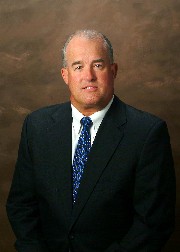Jim Thornton, an alumnus of the Health, Physical Education and Recreation department, became president of the National Athletic Trainers' Association over the summer. He carries out those responsibilities while also working as Clarion University of Pennsylvania’s director of sports medicine and athletic training services.
”I watched the Utah State Athletic Trainers working at a football game and I just knew I wanted to be an athletic trainer,” he said. “That was thirty years ago, and I can’t imagine not doing what I do.”
He’s a busy man, but he took some time to talk to us about his experience at USU, the field of athletic training, and his advice for young athletic trainers preparing to enter the workforce.
Q: Tell me how athletic training has changed over the years.
A: A lot of people have a misperception of what athletic trainers do. The modern athletic trainer is a health care provider, licensed and certified in 49 of the 50 states. We provide health care to people in a vast number of settings. I believe we can access the health care system for those patients and athletes faster than anyone else. As I said athletic trainers provide care in a lot of different places, not just in athletics. There are athletic trainers at NASA taking care of the astronauts, and in the military, and in industries where workers do a lot of heavy lifting and other activities that cause injuries of all kinds. The job is to prevent injuries, but if they do happen we work at getting our patients and athletes back in the game as soon as it is safe.
My goal as an athletic trainer is that our athletes will never look back and say, “They didn’t take care of me at Clarion and that’s why I have to deal with this now.”
The issue of the public recognizing the problems with traumatic brain injury is one of the things that has put us in the forefront. … People don’t realize that athletic trainers have been managing concussions for more than 60 years. This isn’t new for us. It’s new for the public because we’ve had athletes coming forward saying, “I’ve been having problems.”
It’s a bigger, hotter issue today because we know more about traumatic brain injury. Neurology studies have contributed to that. When somebody does get hurt, we try our very best to make sure it’s managed correctly.
Q: Aside from traumatic brain injury, what’s new in athletic training?
A: At NATA we just released a position statement at our national convention, on sudden death and the causes of sudden death in collegiate athletes. This isn’t new, but the position statement is new on how to manage it. It’s all research based. You can find that position statement and others concerning the health and safety of our patients at NATA.org.
Q: How do you keep up with the changes in your field?
A: I’ve enlarged my toolbox, not only to keep up with the profession but also to make sure the care that I’m giving the athletes is the best care that I can provide. I did my master’s degree in sports medicine at the University of the Pacific in Stockton, California. I am also certified in Performance Enhancement and Corrective Exercise by the National Academy of Sports medicine.
I read a lot. We have a very well respected, refereed journal; The Journal of Athletic Training. I study what comes up in it and read the NATA news. I also keep up with the 38,000 athletic trainers who are members. Every one of them has an opinion, and they’re not afraid to share it.
Q: What advice would you give a fresh graduate in athletic training?
A: I would say the same thing that my mentor, Utah State University Head Athletic Trainer Dale Mildenberger said to me: “Be involved.” The NATA and the profession need young people that are fresh, sharp, open minded professionals to take us forward. We need them to need to make a difference in the future. I know this sounds like a cliché, but I cannot stress enough the importance of the involvement of our students and young professionals. Continue to expand your knowledge, and don’t just expand it, employ those things that you learn in the every day management of the health care of your patients. Let the knowledge that you gather never cease, and when you have it, don’t just do what you used to do. Change! Be better at what you do today than you were yesterday!

No comments:
Post a Comment